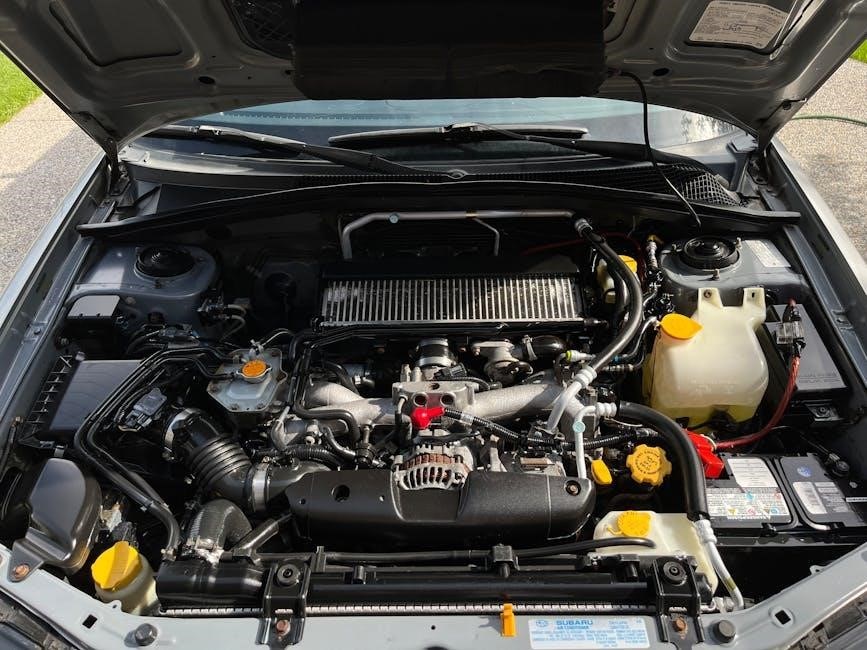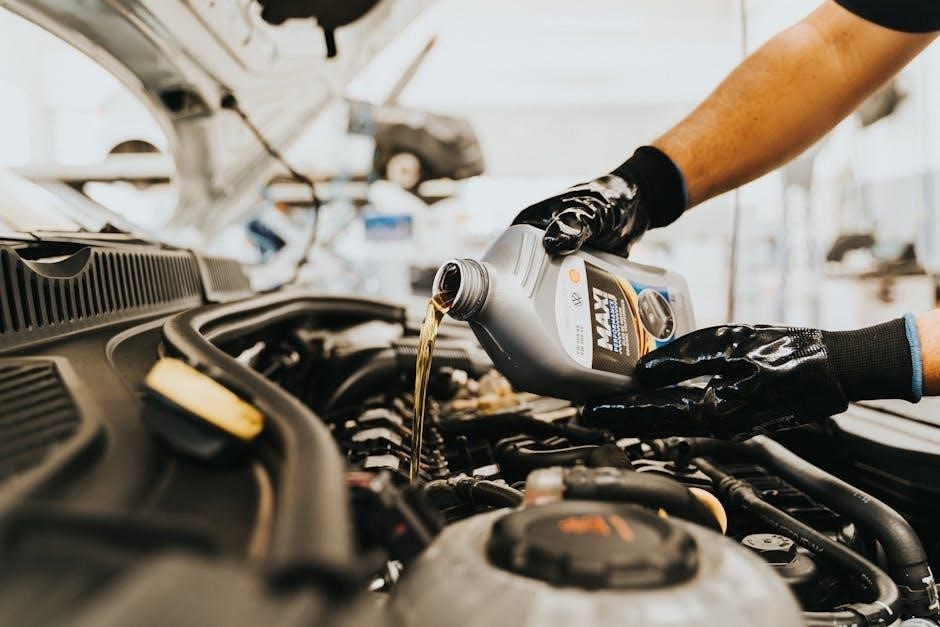Regular manual transmission oil changes are essential for maintaining smooth gear operation and preventing wear. Manufacturers typically recommend intervals of 30‚000 to 60‚000 miles‚ depending on driving conditions and vehicle age.
Overview of Manual Transmission Oil Changes
Manual transmission oil changes are crucial for maintaining gear health and performance. Typically‚ manufacturers recommend changing the oil every 30‚000 to 60‚000 miles‚ depending on driving conditions and vehicle age. Synthetic oils may extend change intervals‚ but it’s essential to follow manufacturer guidelines. Gear oil‚ used in manuals‚ differs from automatic transmission fluid. Regular changes can prevent wear and improve longevity. Factors like heavy traffic or towing may require more frequent changes. Checking the owner’s manual is the first step‚ and considering professional service ensures proper maintenance. Adjusting the schedule based on driving habits and oil type helps optimize transmission life and performance.

The Importance of Manual Transmission Oil
Manual transmission oil lubricates gears‚ prevents wear‚ and reduces friction‚ ensuring smooth operation. It protects the transmission from damage and extends its lifespan‚ making it critical for optimal performance.
Role of Transmission Oil in Vehicle Performance
Transmission oil plays a critical role in ensuring smooth and efficient operation of a manual transmission. It lubricates gears‚ reduces friction‚ and prevents wear on moving components. This prevents overheating and extends the lifespan of the transmission. Additionally‚ it protects against corrosion and cleans the system by carrying away metal particles. Properly lubricated gears ensure smooth shifting and consistent performance‚ while inadequate oil can lead to rough operation and premature wear. Regular oil changes maintain the transmission’s efficiency and reliability‚ ensuring optimal vehicle performance and driver satisfaction.
Consequences of Neglecting Transmission Oil Changes
Neglecting manual transmission oil changes can lead to severe consequences‚ including worn-out gears and increased friction. Without proper lubrication‚ gears may overheat‚ causing premature wear and eventual transmission failure. This can result in costly repairs‚ potentially requiring a full transmission rebuild or replacement. Additionally‚ old oil can become contaminated with metal particles‚ further damaging components. If left unchecked‚ the transmission may experience rough shifting‚ slipping gears‚ or even complete loss of function. Regular oil changes are crucial to prevent these issues and ensure the transmission operates smoothly. Neglecting this maintenance can lead to unreliable performance and significant financial burdens.

General Guidelines for Manual Transmission Oil Changes
Manual transmissions typically require oil changes every 30‚000 to 60‚000 miles‚ depending on manufacturer recommendations and driving conditions‚ with newer cars potentially extending up to 100‚000 miles.
Typical Manufacturer Recommendations
Manufacturers generally advise changing manual transmission oil every 30‚000 to 60‚000 miles. Some recommend up to 100‚000 miles for low-stress driving‚ while others suggest intervals as low as 30‚000 miles for high-stress conditions. Synthetic oils may extend these intervals‚ but adherence to the owner’s manual is crucial for warranty and longevity. Regular inspections and fluid checks ensure optimal performance‚ preventing costly repairs. Factors like frequent stop-and-go traffic or towing may necessitate more frequent changes. Always consult the vehicle’s manual for specific guidance tailored to your make and model‚ ensuring adherence to recommended maintenance schedules for enhanced transmission life and performance.
Interval Ranges: 30‚000 to 100‚000 Miles
Manual transmission oil change intervals typically range from 30‚000 to 100‚000 miles‚ depending on driving conditions and vehicle usage. For standard driving‚ many manufacturers suggest changes every 60‚000 to 80‚000 miles. However‚ for high-stress conditions like frequent stop-and-go traffic‚ towing‚ or off-road driving‚ more frequent changes‚ such as every 30‚000 to 50‚000 miles‚ are recommended. Synthetic oils may allow for longer intervals‚ up to 100‚000 miles‚ but this varies by manufacturer. Regular fluid checks and inspections are crucial to ensure optimal performance and prevent premature wear. Adhering to these intervals helps maintain smooth gear operation and extends the lifespan of the transmission‚ avoiding costly repairs down the road.

Factors Influencing Oil Change Frequency
Driving conditions‚ vehicle age‚ and mileage significantly affect how often manual transmission oil changes are needed. Harsh driving conditions and older vehicles may require more frequent changes.
Driving Conditions and Their Impact
Driving conditions play a crucial role in determining how often manual transmission oil changes are needed. Vehicles subjected to frequent stop-and-go traffic‚ towing‚ or off-road driving experience increased wear on the transmission. This is because such conditions generate excessive heat and stress‚ which can degrade the oil faster. Additionally‚ city driving with constant shifting and high-stress environments like construction zones or hilly terrains can reduce the oil’s effectiveness. Manufacturers often recommend more frequent oil changes for vehicles operating under these conditions to ensure optimal performance and longevity. Regular inspections and adherence to these guidelines help maintain the transmission’s health and prevent premature damage. Proper maintenance under such conditions is vital for smooth operation and extending the lifespan of the manual transmission. These factors highlight the importance of adjusting oil change intervals based on usage patterns. Therefore‚ understanding and adapting to driving conditions is essential for maintaining the vehicle’s transmission system. Always consult the owner’s manual for specific recommendations tailored to your vehicle and driving habits.
Vehicle Age and Mileage Considerations
Vehicle age and mileage significantly influence the frequency of manual transmission oil changes. Older vehicles or those with high mileage often require more frequent oil changes due to increased wear and tear on internal components. As a vehicle ages‚ the transmission oil becomes less effective at lubricating and protecting gears‚ leading to potential damage. High-mileage vehicles‚ typically those exceeding 100‚000 miles‚ may need oil changes every 30‚000 to 50‚000 miles to maintain optimal performance. Newer vehicles‚ however‚ can usually follow the standard manufacturer recommendations. It’s important to consider both the age and mileage when determining the best interval for oil changes‚ as these factors directly impact the transmission’s health and longevity. Always consult the owner’s manual for specific guidance tailored to your vehicle’s needs. Regular maintenance ensures smoother operation and extends the lifespan of your manual transmission. Proper care is essential for preserving your vehicle’s performance over time.

Manual vs. Automatic Transmission Oil Changes
Manual transmissions typically require more frequent oil changes (30‚000-60‚000 miles) compared to automatics (60‚000-100‚000 miles)‚ due to higher wear and tear in manual systems.
Differences in Service Intervals
Manual and automatic transmissions have distinct service intervals due to their mechanical differences. Manual transmissions typically require oil changes every 30‚000 to 60‚000 miles‚ as the gear oil lubricates moving parts under constant engagement and disengagement. Automatic transmissions‚ relying on transmission fluid‚ often have longer intervals of 60‚000 to 100‚000 miles. These differences stem from the varying demands on the fluid and the internal components. Manual transmissions experience more wear due to clutch engagement and shifting‚ necessitating more frequent maintenance. Automatics‚ while requiring less frequent changes‚ still benefit from regular fluid replacement to maintain smooth operation and prevent overheating. Driving conditions‚ such as frequent stop-and-go traffic or towing‚ can reduce these intervals for both types‚ emphasizing the importance of adhering to manufacturer guidelines for optimal performance and longevity.
Why Manual Transmissions Require More Frequent Changes
Manual transmissions require more frequent oil changes due to the mechanical demands of constant gear engagement and disengagement. The gear oil in manual transmissions is subjected to higher heat‚ friction‚ and wear compared to automatics. This leads to faster degradation of the oil’s lubricating properties. Additionally‚ manual transmissions often involve more direct stress on components like the clutch and synchros‚ which can introduce contamination and wear. Fresh oil is essential to maintain smooth shifting‚ prevent overheating‚ and ensure the longevity of internal components. As a result‚ manufacturers recommend changing manual transmission oil every 30‚000 to 60‚000 miles‚ unlike automatics‚ which can often go up to 100‚000 miles between changes. This makes regular maintenance crucial for manual transmissions to function optimally and avoid premature wear.

Signs Your Manual Transmission Oil Needs Changing
Visible indicators include dark‚ gritty oil and metal particles. Performance issues like rough shifting‚ grinding noises‚ or delayed engagement signal the need for a change.
Visible Indicators of Worn-Out Oil
Worn-out manual transmission oil often appears dark‚ gritty‚ or contains metal particles. Its consistency may thin‚ losing viscosity. These visible signs indicate degraded lubrication quality and the need for a change.
Performance Issues Linked to Old Oil
Old transmission oil can cause sluggish shifting‚ grinding gears‚ and hesitation between gears. Over time‚ this leads to increased wear on synchronizers and gear teeth‚ potentially resulting in costly repairs if ignored.

Diy vs. Professional Service

DIY vs. Professional Service
DIY manual transmission oil changes can be cost-effective but require proper tools and knowledge. Professional services offer expertise but at a higher cost.
Pros and Cons of DIY Oil Changes
DIY manual transmission oil changes can be cost-effective and satisfying for car enthusiasts. Pros include saving money‚ learning about your vehicle‚ and convenience. However‚ cons involve technical difficulty‚ mess‚ and potential environmental disposal issues. DIY requires proper tools and knowledge to avoid errors. While it’s a great way to maintain your car‚ it’s important to weigh the benefits against the risks of improper execution. Always follow manufacturer guidelines to ensure longevity and performance of your transmission.
When to Seek Professional Assistance
Seeking professional help for manual transmission oil changes is advisable in certain situations. If you’re unsure about the process or lack the necessary tools‚ a mechanic can ensure it’s done correctly. Additionally‚ if your vehicle has high mileage or specific manufacturer requirements‚ professionals are better equipped to handle specialized needs. They can also diagnose any underlying issues during the service. While DIY is cost-effective‚ professional assistance guarantees quality and reliability‚ especially for complex or high-performance vehicles. It’s a wise investment to prevent potential damage and maintain your transmission’s health‚ particularly if you’re not confident in your ability to perform the change accurately.

Best Practices for Manual Transmission Oil Changes
Always use the manufacturer-recommended oil type and follow the specified intervals. Ensure proper tools and materials are on hand for a clean‚ efficient process.
Choosing the Right Oil Type
Selecting the correct oil for your manual transmission is crucial for optimal performance. Always refer to your vehicle’s manual to determine the recommended oil type‚ as specifications vary by manufacturer and model. Most manual transmissions require gear oil‚ which is different from automatic transmission fluid (ATF). Synthetic oils are often preferred for their superior lubrication and temperature resistance‚ especially in high-stress driving conditions. Conventional oils may suffice for average driving but lack the durability of synthetics. Using the wrong oil type can lead to premature wear‚ gear damage‚ or even transmission failure. Consider factors like driving habits‚ climate‚ and vehicle age when selecting oil. Ensure compatibility with your transmission’s material‚ such as brass or steel components‚ to avoid chemical reactions. Proper oil selection ensures smooth shifting‚ reduces friction‚ and extends the lifespan of your manual transmission.
Tools and Materials Needed
- Socket set: A 3/8″ or 1/2″ drive socket set is essential for draining the transmission oil and removing the drain plug.
- Drain pan: A large‚ sturdy pan is needed to catch the old oil during draining.
- New oil filter: Replace the old filter with a high-quality one to ensure clean oil circulation.
- Gasket or seal: A new gasket is often required to prevent leaks after refilling.
- Transmission oil: Use the manufacturer-recommended gear oil for optimal performance.
- Funnel: A funnel helps pour in the new oil without spilling.
- Rags: For cleaning up spills and wiping surfaces.
- Work stands or jack: To safely lift the vehicle for better access.
- Torque wrench: To tighten bolts and plugs to the correct specification.
- Gloves and safety glasses: For personal protection during the process.
Ensure all tools and materials are ready before starting the oil change to avoid delays. Refer to your vehicle’s manual for specific requirements.

Maintenance Tips Beyond Oil Changes
Regular inspections‚ checking fluid levels‚ and inspecting for leaks are crucial. Following manufacturer recommendations ensures optimal transmission health and performance over time.
Additional Practices for Transmission Longevity
Beyond regular oil changes‚ maintaining a manual transmission involves avoiding extreme driving conditions‚ checking for fluid leaks‚ and ensuring proper gear engagement. Using the correct oil type and avoiding overheating are also critical. Regular inspection of transmission mounts and driveshaft components can prevent major repairs. Avoiding aggressive shifting and not riding the clutch reduces wear on synchronizers and bearings. Ensuring proper alignment during installation of new parts prevents uneven gear wear. These practices‚ combined with timely professional inspections‚ help extend the life of the transmission and maintain optimal performance over time. Consistency in maintenance routines ensures the transmission operates smoothly for years‚ even under demanding conditions.
Importance of Regular Vehicle Inspections
Regular vehicle inspections are crucial for identifying potential issues before they escalate. For manual transmissions‚ inspections can reveal worn-out gears‚ leaks‚ or contaminated fluid. Early detection prevents costly repairs and ensures smooth operation. Inspecting the clutch‚ driveshaft‚ and mounts helps maintain transmission health. Additionally‚ checking fluid levels and condition during inspections ensures timely changes‚ preventing overheating and wear. Regular inspections also help track the effectiveness of maintenance routines‚ such as oil changes‚ aligning with manufacturer recommendations. By incorporating inspections into your maintenance schedule‚ you can extend the lifespan of your transmission and avoid unexpected failures‚ ensuring reliability and performance over time.
Regular manual transmission oil changes are essential for optimal performance and longevity. Generally recommended every 30‚000 to 60‚000 miles‚ depending on driving conditions‚ proper maintenance ensures smooth operation and prevents costly repairs. Always refer to your vehicle’s manual for specific guidelines.
Manual transmission oil changes are crucial for maintaining optimal performance and longevity. Most manufacturers recommend changing the transmission oil every 30‚000 to 60‚000 miles‚ with some suggesting up to 100‚000 miles under normal driving conditions. However‚ factors such as extreme driving habits‚ frequent stop-and-go traffic‚ or towing may require more frequent changes. Always consult your vehicle’s owner’s manual for specific guidelines. Using high-quality synthetic oils can extend the interval‚ but consistency is key. Regular inspections and addressing performance issues promptly are also vital. By following these recommendations‚ you ensure smooth gear operation‚ prevent wear‚ and avoid costly repairs. Consistent maintenance is the cornerstone of extending your manual transmission’s lifespan.
Final Thoughts on Transmission Oil Change Frequency
Changing manual transmission oil every 30‚000 to 60‚000 miles is a simple yet effective way to protect your vehicle’s gearbox. Regular maintenance ensures smooth shifting‚ reduces wear on components‚ and prevents costly repairs. While some newer vehicles may allow longer intervals‚ adhering to manufacturer guidelines remains the best practice. Factors like driving style‚ mileage‚ and vehicle age play a role in determining the ideal frequency. By staying proactive and monitoring your transmission’s health‚ you can extend its lifespan and maintain optimal performance. Remember‚ transmission oil is a critical component‚ and neglecting it can lead to premature failure. Consistency in maintenance is key to keeping your manual transmission running smoothly for years to come.
